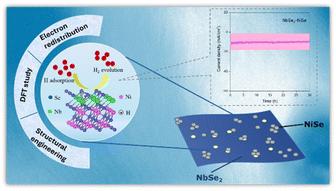电子重分布增强了NbSe2-NiSe纳米异质结构的析氢活性
IF 9.5
2区 材料科学
Q1 CHEMISTRY, PHYSICAL
引用次数: 0
摘要
基于过渡金属二硫族化合物(TMDs)的纳米异质结构(NHSs)通过电子结构调制、增加活性位点密度和改善电导率在调节催化性能方面发挥着重要作用。然而,基于tmd的NHSs金属-金属界面接触处的电子结构在催化中的意义仍未得到充分研究。在这项研究中,我们展示了具有金属-金属界面的NbSe2-NiSe NHSs的设计,用于电催化析氢反应(HER)。通过结合实验和理论研究,我们建立了NiSe纳米板和NbSe2纳米片(NSs)之间的协同相互作用,导致电子重新分布,从而降低NbSe2 - NiSe纳米片的过电位值。利用密度泛函理论(DFT)进行的吉布斯自由能计算(ΔGH*)表明,由于在界面处形成了内置电场,异质结处氢的能垒明显降低。我们的研究结果通过建立一种综合研究决定电催化特性的因素的方法,阐明了金属-金属界面接触在调节nb基NHSs催化活性中的作用。本文章由计算机程序翻译,如有差异,请以英文原文为准。

Electron redistribution assisted enhanced hydrogen evolution activity of NbSe2–NiSe nanoheterostructures
Nanoheterostructures (NHSs) based on transition metal dichalcogenides (TMDs) play a vital role in regulating catalytic properties through electronic structure modulation, increased active site density, and improved electrical conductivity. However, the significance of electronic structures at the metal–metal interfacial contacts of TMD-based NHSs in catalysis remains largely unexplored. In this study, we demonstrate the design of NbSe2–NiSe NHSs featuring metal–metal interfaces for the electrocatalytic hydrogen evolution reaction (HER). By combining experimental and theoretical studies, we establish synergistic interactions between NiSe nanoplates and NbSe2 nanosheets (NSs), leading to electron redistribution and a consequent reduction in overpotential values of NbSe2–NiSe NHSs for HER. Gibbs free energy calculations (ΔGH*) using density functional theory (DFT) show a pronounced reduction in the energy barrier for hydrogen at the heterojunction owing to the formation of a built-in electric field at the interfaces. Our findings elucidate the role of metal–metal interfacial contacts in modulating the catalytic activity of Nb-based NHSs by establishing a method to comprehensively investigate the factors that dictate electrocatalytic characteristics.
求助全文
通过发布文献求助,成功后即可免费获取论文全文。
去求助
来源期刊

Journal of Materials Chemistry A
CHEMISTRY, PHYSICAL-ENERGY & FUELS
CiteScore
19.50
自引率
5.00%
发文量
1892
审稿时长
1.5 months
期刊介绍:
The Journal of Materials Chemistry A, B & C covers a wide range of high-quality studies in the field of materials chemistry, with each section focusing on specific applications of the materials studied. Journal of Materials Chemistry A emphasizes applications in energy and sustainability, including topics such as artificial photosynthesis, batteries, and fuel cells. Journal of Materials Chemistry B focuses on applications in biology and medicine, while Journal of Materials Chemistry C covers applications in optical, magnetic, and electronic devices. Example topic areas within the scope of Journal of Materials Chemistry A include catalysis, green/sustainable materials, sensors, and water treatment, among others.
 求助内容:
求助内容: 应助结果提醒方式:
应助结果提醒方式:


